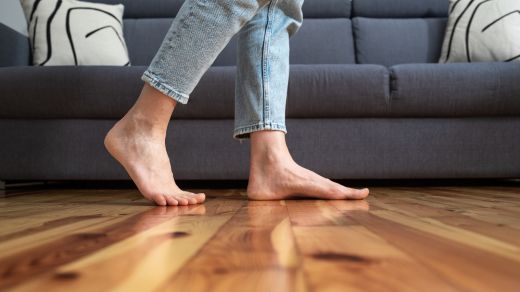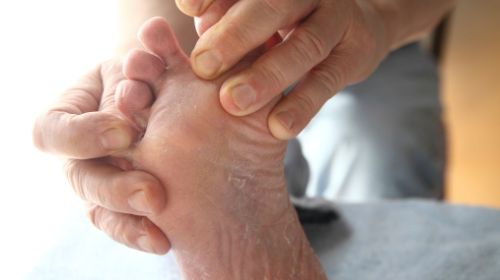Splayfoot occurs when the forefoot spreads. The foot malposition occurs quite often and usually has no clinical significance. But the unequal pressure distribution that weighs on the foot as a result can have consequences.
- © Getty Images/brizmaker
Quick Overview: Splayfoot
Definition: The transverse arch of the foot lowers, causing the forefoot to widen. Pressure is distributed unevenly across the metatarsal bones.
Symptoms: Metatarsal pain (metatarsalgia) can occur and calluses can form on the ball of the foot. Hallux valgus (bunions), claw toes or hammer toes often develop as a result.
Treatment: Therapy is only required if there are symptoms. First, conservative measures such as insoles, physiotherapy and painkillers are tried. If this is unsuccessful, an operation may be necessary.
Article content at a glance:
What is splayfoot?
The splayfoot (pes transversoplanus) is a frequently occurring foot deformity, which usually has no clinical significance. The front part of the foot is widened and there can be an unnatural distribution of pressure on the metatarsal bones.
When walking and standing, the feet are normally loaded on the first and fifth metatarsal heads due to the upward transverse arch of the forefoot. With splayfoot, however, the front transverse arch of the foot lowers and the forefoot spreads because the metatarsal bones move further apart.
In most cases, women are affected by splayfoot. It often occurs in combination with a pes cavus or flat foot.
Pain when walking: Symptoms of splayfoot
By lowering the transverse arch of the foot, the pressure is also distributed to the second to fourth metatarsal heads. However, these areas are not used to the stress. As a result, sometimes
- calluses
- cornea,
- Inflammation of the metatarsophalangeal joints
- and painful spots.
Especially when rolling and stepping on uneven ground, severe pain can occur when walking. Sufferers try to avoid this metatarsal pain (metatarsalgia) by intentionally only loading the outside of the foot. Mild forms of splayfoot are not necessarily accompanied by pain.
Weak muscles favor splayfoot
A splayfoot is not innate. It only develops in the course of life through the influence of various factors. Possible causes of splayfoot are:
- weak muscles
- weakened connective tissue
- genetic predisposition
- pointed shoes, high heels
- lack of exercise
- overweight
- Overload, for example due to long standing activities
- rheumatic diseases
Splayfoot is particularly common in women after the menopause – regardless of whether they have worn unsuitable shoes.
Foot malpositions such as pes cavus and pointed foot can also lead to splayfoot due to the constant overload. In addition, splayfoot can occur as a result of poliomyelitis (polyomyelitis) or several chronic joint inflammations (polyarthritis).
X-rays provide visual diagnosis of the splayfoot
Doctors can usually identify splayfoot by the appearance of the foot and the symptoms present. The malposition is characterized by a widened metatarsus and a lowered arch of the foot. Pressure-sensitive calluses have often formed on the balls of the feet.
X-rays show changes in the bones and joints. This is carried out in case of doubt and to rule out that flat feet or fallen arches are not responsible for the symptoms.
Insoles, foot exercises or surgery: treat splayfoot
Once splayfoot has developed, the foot cannot be brought back to its original shape. Its normal function also remains impaired. The treatment is therefore primarily aimed at relieving the foot and reducing the pain for those affected.
As part of conservative therapy, patients should only wear suitable footwear – suitable insoles (e.g. splayfoot insoles, rigid shoe soles) can be used to relieve the strain. Taping can also provide temporary relief. Foot exercises and targeted training such as walking barefoot can strengthen the foot muscles. The guidance is best provided by physiotherapist-trained professionals.
In case of inflammation
- alternating showers,
- alkaline foot baths with Dead Sea salt,
- cooling
- or anti-inflammatory and pain-relieving drugs can help.
operation of the deformity
If the conservative treatment approaches are unsuccessful, an operation can correct the foot deformity. This should restore the resilience of the forefoot in everyday life. If possible, the operation should be performed by doctors who specialize in podiatry.
Hallux valgus can be the result of splayfoot
One consequence of the splayfoot can be a crooked big toe, the hallux valgus. The big toe tends towards the smaller toes and pushes them to the side. This misalignment is more common in women. It is usually caused by tight and pointy shoes.
Other possible toe misalignments as a result of splayfoot are hammer toes and claw toes.
Avoid tight and too high shoes to prevent splayfoot
Splayfoot can be prevented by avoiding wearing high and tight shoes as often as possible. Long standing activities should also be avoided as far as possible in order not to overload the feet.
Being overweight can also promote foot malpositions, since increased pressure is exerted on bones and ligaments. Therefore, if possible, weight loss should be aimed at until you reach a normal weight. A balanced, healthy diet and sufficient exercise in everyday life are recommended.


